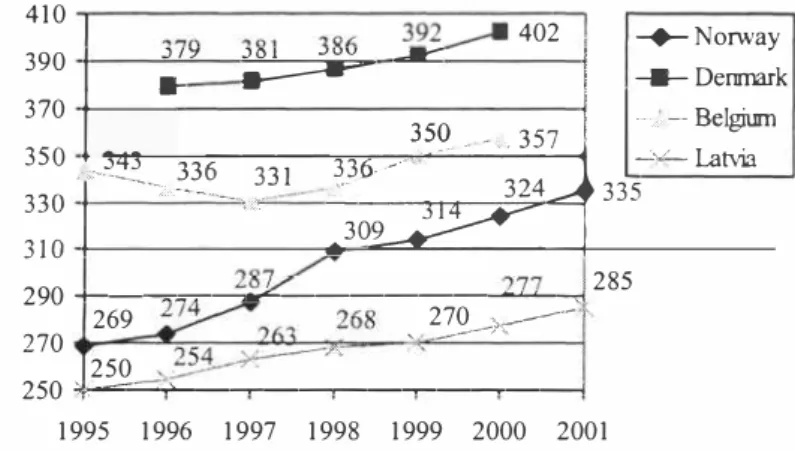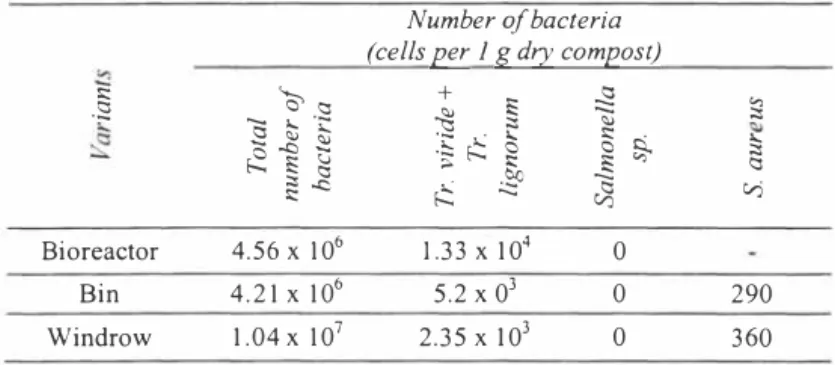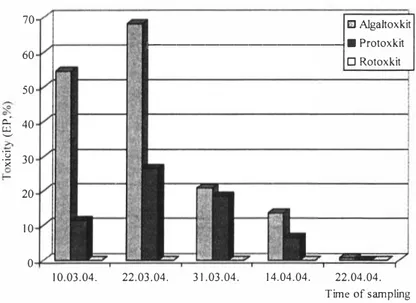Kalmar ECO-TECH '05 and
The Second Baltic Symposium on Environmental Chemistry KALMAR, SWEDEN, November 28-30, 2005
BIOW ASTE RECYCLING TECHNOLOGIES IN
LATVIA
Kristina Meiapul;ce
1Rute Bendere
1Dz. Zaril;a
2L. Dubova
2 1Waste Management Association of Latvia, Latvia
2University of Latvia, Latvia
ABSTRACT
Protection of environment is a worldwide problem. Generation of organic waste is increasing and strategies for its environmentally sound use must be developed and optimised. Accumulation of great quantities of organic wastes leads to the serious environmental problems: polluted water, contaminated soils, polluted air and solid wastes. Waste water treatment plants produce in large quantities sewage sludge. Among the different types of municipal organic wastes sewage sludge is the main product.
Waste Management plan for Latvia sets that disposed biodegradable waste amount till 2010 must not exceed 75 % from the biodegradable waste amount disposed in 1995. Proposal for the Strategy on biodegradable waste management were elaborated by Waste Management Association of Latvia (WMAL), and in collaboration with Institute of Microbiology and Biotechnology, University of Latvia an approbation of organic municipal waste composting technologies is performed in the frames of LIFE - ENVIRONMENT program project in Riga district.
KEYWORDS
Municipal and industrial waste; Composting technologies; Microorganisms 1 INTRODUCTION
The treatment of the biodegradable waste is an actual question in various European countries int. al. in Latvia. The predicted amount of household waste per inhabitant in Latvia [1] and biodegradable waste percentage in it for next decades compared with the same parameters for several European countries are presented in Figures 1 and 2. Elaborated forecast for produced waste amount shows that household waste as well the biodegradable waste amount will increase.
As it is shown on the
Latvia during the period of 1995 Figure 1,-the household waste amount generated by inhabitants in 200 I were less then in the selected countries, but the waste grow tendencies are similar as in other European countries. Figure 2 shows that
�
� ��
,., :S 410 402--+--No�,,
....
J/7 JOl �vv ..--:: 390 (!)I
---==---
I
_._
Dem=k..:.:
OJ) 0,, 3 7 0I
-I
.-•::�j,J,
350��
��
-z----::�
350 ,, _I
,-
�
}
-'
'-1
"
290 +---=�--,---��-285 269 ' 270 --s, ----·-_c 0 ::r:: 270 250.
250-==---�--�-�-�-
---1995 1996 1997 1998 1999 2000 2001'
Figure 1. Changes of household waste amount in European countries and in Latvia in period 1995 -2001[1, 2, 3}. 71 68 69 1-+-NOiway
E
(!) 69t
67 --- Dernnark 0,, %j 65 65 -·.-Belgium � 63 I (!) 61 61 61 �Latvia � 61 "O � 59 "O ::>tsJi
(!)_,,
'P,7 •,7 • .. :;--•M.-
♦ 56 55 1995 1996 1997 1998 1999 2000 2001Figure 2. Percentage changes of biodegradable waste part in European countries and in Latvia in period 1995 -2001 [l, 2, 3).
biodegradable waste percentage in the household waste is like in Latvia, Belgium and Norway.
It was stated that an average biodegradable waste amount in Latvia in 1995 was 488 000 tones, which set approximately 53 % of total municipal (from households and industry) waste. So, according to the State waste management plan [4] the treated biowaste amount must increase till 122 000 tones per year in 20 I 0. To promote the implementation of this task, we
Kalmar ECO-TECH '05 and
The Second Baltic Symposium on Environmental Chemistry
KALMAR, SWEDEN, November 28-30, 2005
need to elaborate biotechnologies for rapid and high quality composting for separately sorted and collected biodegradable waste streams. The biodegradable treatment technologies were compared from economical, technical and environmental point. It was acknowledged that as the best for the Latvian circumstance is an aerobic composting,
Composting is a biological process, converting organic matter in the presence of suitable amounts of air and moisture into humus-like product, in which the microbial activity is essential for the decomposition and bio-oxidation of organic materials, Waste materials can be stabilized before deposition by aerobic degradation processes to reduce the biodegradable organic material,
Composting of municipal wastes may follow two main purposes:
(I) decreasing the reactivity of municipal wastes or waste fractions before deposition
in sanitary landfills or
(2) preparation of soil conditioner or a natural fertilizer from plant materials and biowastes fractions,
Feedstock can be characterized by chemical, physical and biological parameters including moisture content, particle size, organic matter content, nutrient content, heavy metal content, and synthetic content.
The aim of this work was specifying of composting conditions for different types of waste and evaluation of the quality of the final product.
2 MATERIALS AND METHODS
Composting processes were realized in a solid state bioreactor (volume 3 L) and in a composting Bin (Biolan Juwel BIO) (volume 600 L), In field conditions, the composting processes were carried out in a windrow, A windrow was 2-3 m in height, 3 min width and 12 m in length. During the first two months in a windrow and one month in a bioreactor, the composting process was realized under anaerobic conditions; then it was continued under aerobic conditions, while the composting process in a Bin was realized under facultative anaerobic conditions.
For the improvement of the composting process two Trichoderma strains: Tr. viride and Tr,
lignorum, as well as nitrification association, which regulates the circulation of nitrogen
-ammonification and nitrification processes, were applied,
The material for composting was prepared as follows: domestic organic waste with sawdust and inoculum was prepared, i,e. mixed and humidified out of a bioreactor, a Bin and windrow, Place the raw materials in layers using balance to high carbon (moist) and low carbon ( dry) materials. Each layer should be no more than IO to 15 cm in depth, Spray each layer with inoculum,
Procedure:
Step I, Start a IO to 15 cm layer of coarse material set on bottom of the composter or on top of the soil,
Step 2. Add a 7 to IO cm layer oflow carbon material, Step 3, Add a IO to 15 cm layer of high carbon material,
Step 4, Add a 2,5 cm layer of garden soil or finish compost, or inoculum of microorganisms,
Step 5. Mix the layers of high carbon material, low carbon material, and soil or compost, or inoculum.
Repeat steps 2 through 5 until the bioreactor and bin is filled and windrow reached 3 m. New materials should be added to the composting system during turning or mixing.
General physical - chemical characteristics of compost were determined: moisture, pH, organic carbon, total nitrogen, C:N ratio etc (5). The quantification of the total number of microorganisms, fungi, Escherichia coli and Salmonella sp. in the compost was performed. The quality of manure composts has been determined using the seed germination tests ( cress salad, tomato and cucumber). Besides, plants were cultivated in compost, and the quality of plants properties was characterized as follows: biomass, length and the content of different pigments in leaves [6].
3 RESULTS
The quality of compost was characterized by pH, moisture, total C and N, C:N ratio, determined by biological tests and microbiological analyses. Figure 3 shows the change of the parameters of compost during the composting process for used technologies.
50
45
40
35
30
25
20
15
10
5
0
Eil Bioreactor■
Bin D WindrowpH C:N ratio Dry Matter, %
�
:::.,
"-�
93
Kalmar ECO-TECH '05 and
The Second Baltic Symposium on Environmental Chemistry KALMAR, SWEDEN, November 28-30, 2005
Table J, Comparison of differenr organic waste composting technologies (the amount of microorganisms in compost)
Number of bacteria (cells per 1 g dry compost)
s::: +
"'
,:::1 � <::s !:�
:::� � -�
._
s::: - -0 .,:s �
0 0�
::: �!:ti :,. s::: <::s ::: <::s�
.§ s::: -0�
vj Bioreactor 4,56 X 106 L33 X 104 0 Bin 4,21 X 106 5,2 X 03 0 290 Windrow 1,04 X 107 2,35 X 103 0 360Table 2, Compost quality (biological tests with cress salad) during the composting process in the windrow
Seeds germination tests
Date Germination, % Roots length (average)
mm % of control
10,03,04, 15,78 33,13
22,03,04, 100 18,10 38,00
31,03,04 100 20,66 54,58
14,04.04. JOO 19,50 40.94
Figure 3 and Table 1 show that the most qualitative compost from household waste was obtained in
a bioreactor, The compost can be used in gardens and fields, because it can provide valuable nutrients and organic matter to soil, However, the compost obtained either from a Bin or a windrow contained Staphylococcus aureus. Therefore, this material is applicable only for waste dump recultivation,
During composting a more significant decrease in the compost toxicity level was determined with Toxkit microbiotests. Seeds germination tests did not show any toxic effects (see
70 60 50 C.: 40
:::,
'u
30'x
20 10 0 El Algaltoxkit 1---i■
Protoxkit D Rotoxkit 10,03,04, 22,03,04, 31,03,04, 14,04,04, 22,04,04, Time of samplingFigure 4, The compost quality (toxicity) during composting process in the windrow
a- immature compost b- control c- quality compost
Figure 5. Cressalad (Lepidum sativum L) cultivation on the peat (control) and immature, and quality compost
Kalmar ECO-TECH '05 and
The Second Baltic Symposium on Environmental Chemistry KALMAR, SWEDEN, November 28-30, 2005
Table 3, Price of I ton of compost material using different technologies
Composting technologies Costs pertt (relative units)
Small facility Big facility
( 4400 t/year) ( 11000 t/year)
Open air technology 12 11
Composting using bioreactor 20 1 2
Windrow technology II 12
Composting using plastics sacks I 3 7
On this basis two types of biowaste treatment schema were revised - the development of many small composting facilities (- 4 000 tones annually), or to organize one big composting facility in the region with 200 000 inhabitants were can be treated - 11 000 tones of biowaste annually, The Table 3 shows the calculated expenses for one ton of produced bio compost with different methods,
In the frame of provided project can be stated: to obtain the compost of a good quality, the composting material needs to be treated under thermophylic conditions in bioreactor, and afterwards - placed in windrow to continue the process, Aeration in windrows should be provided by intensive mixing, Moisture content in windrows can be maintained by additional moistening, if necessary.
4 CONCLUSIONS
o Performed chemical and microbiological analyses demonstrated that the high quality compost is obtained by waste treatment in bioreactor,
o The high quality compost is without sawdust particles and nuisance of odor, no toxic compounds were detected with used microbiotests,
o Compost of lower quality may be used for the remediation of old dumpsites.
o During the work was established that the optimization of the characteristics of waste mass and the reduction of the concentration of possible toxic impurities are important factors for the successful composting process,
REFERENCES
[ I] "Priekslikumi strategijai par biologiski noardamo atkritumu apsaimniekosanu atbilstosi Eiropas Padomes direkfivas 1999/31 /EC par atkritumu apglabasanu un Ministru kabineta 2002, gada 3. janvara noteikumu Nr. 15 prasibam" (,,Proposals for the Strategy on Biodegradable Waste Management in accordance with the Requirements of Europe Council Directive 1999/31/EC on Waste Disposal and Requirements of Regulations issued by the Cabinet of Ministers Nr, 15 (03. 0 1.2002)"), pp. 14-20 (in Latvian). [2] Statistics Norway, Household waste, 2002, http://www.ssb.no
[3] Indicator Fact Sheet Signals 200 I, European Environmental Agency, http://themes.eea,eu,int
(SJ Viesturs, U,, Zarii;ia, Dz. , Strikauska, S, , Dubova, L, Berzii;is, A., 2004, Solid State Fermentation Systems for Bioremediation and Biodegradation, LLtU Raksti, 12 (307), 1-8,
[6] Dubova, L, Zarina, Dz., 2 004, , Application of Toxkit Microbiotests for Toxicity Assessment in Soil and Compost, Environmental Toxicology, Australia 19, 274-279,


